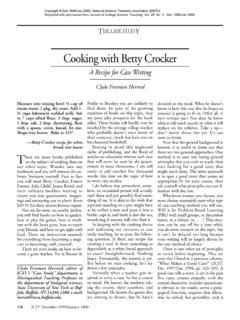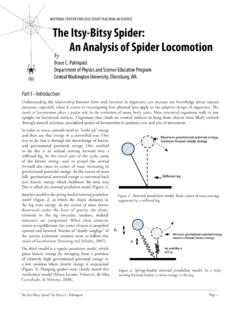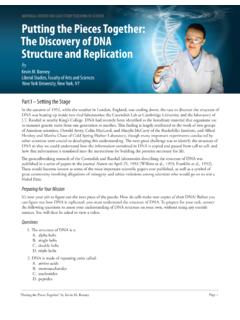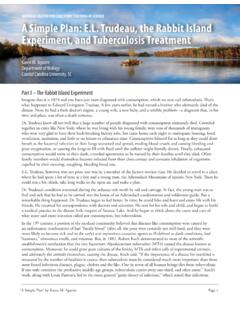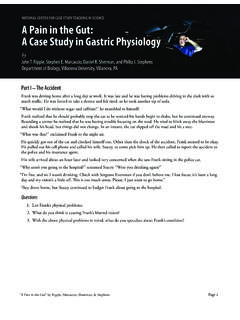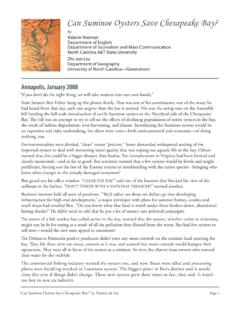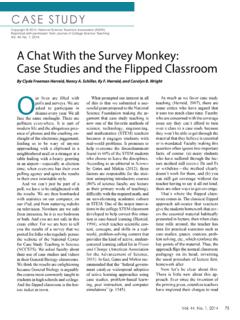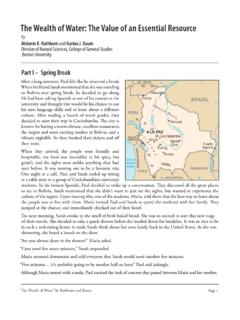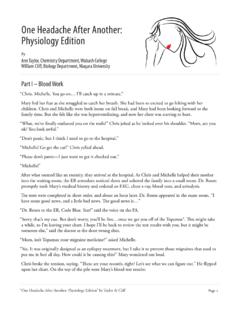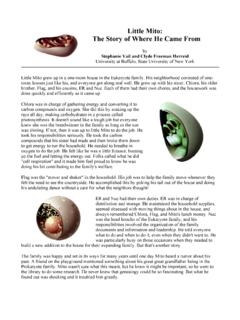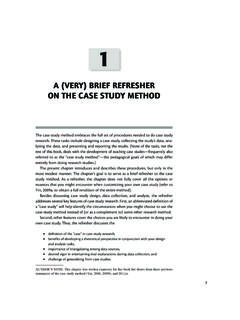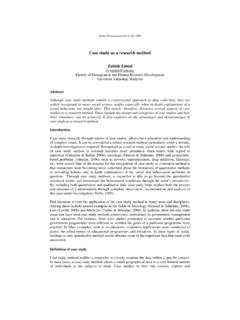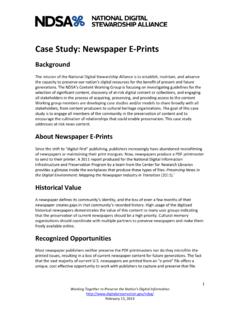Transcription of THE CASE STUDY - sciencecases.lib.buffalo.edu
1 February 2000 JCST225 There was something in Bobby thatwanted to do it all. He wanted to playthe part, dance the part, conduct the or-chestra, produce the play. It was a kindof an obsession with him. Robert WhiteheadBob Fosse died on the streets ofWashington, , on September23, 1987, in the arms of his dancerwife, Gwen Verdon. He was withinsight of the National Theater where hisdancers were dressing for a revival ofhis show Sweet was a Broadway legend, start-ing his career as a teenage hoofer inChicago. As fine a dancer as he was,it was as a choreographer that hemade his mark with shows like Caba-ret, Pajama Game, Damn Yankees,Chicago, Pippin, and, of course, Allthat are the case teach-ers of the dance world.
2 The modernClyde Freeman Herreid, editor ofJCST s case STUDY department, isDistinguished Teaching Professor inthe department of biological sciences,State University of New York at Buf-falo, Buffalo, NY 14260-1300; All That JazzAn Essay Extolling the Virtues of WritingCase Teaching NotesClyde Freeman Herreidgreats like Martha Graham, GeorgeBalanchine, Jerome Robbins, andAgnes de Mille take a musical score, aline of a poem, or an image and cre-ate a terpsichorean masterpiece thatcan inspire, provoke, titillate, irritate,or enrapture audiences. Unlike pastmasters, today s choregographers leavenotes and videos to help others seetheir is something ironic, though,about giving explicit instructions onhow to play or dance to jazz.
3 My fa-ther, a vaudevillian and jazz pianistwho banged about the country withdance bands in the 1930s, put it to methis way: Jazz is for the moment. Itshould never be written down or re-corded. It is a once-in-a-lifetime s never the same the next time youplay it. It is for the musicians who playit and the listeners who are there at themoment. It is for the now. The mo-ment that you regiment it, it s nolonger yet, we do record it and regi-ment it, at least to varying jazz musicians need a melody lineto guide them through their riffs. Soit is with case teachers. That s whatcase teaching notes are a melody lineto show the way.
4 They can be used asgospel, as a big band leader might in-sist, or ignored of us seek a little guidance, es-pecially newcomers, folks who like thestyle but cannot spend years in a Chi-cago bar or a New Orleans brothel tocapture the rhythm and tone of a JellyRoll Morton. Perhaps we are not des-tined to be a Dizzy Gillespe, but westill can learn how to play a reasonablejazz number or run a case . We don thave to accept Louie Armstrong sdreaded pronouncement in reply tothe question, What is jazz? Man, ifyou gotta ask, you ll never know. Ignoring Satchmo s admonition, orat least not generalizing it to includecase STUDY teaching, I have in severalcolumns attempted to answer thequestion, What is a case ?
5 Here, Icommit the further effrontery of sug-THE case STUDYLike jazz, case studies arenever played the same wayin any two settings. That iswhat makes them are for the now forthe moment. Sometimesthey are 2000, National Science Teachers Association (NSTA). Reprinted with permission from Journal of College Science Teaching, Vol. 29, No. 4, February February 2000gesting how one can help others teachcases by writing good teaching all, as teachers, explaining is ourbusiness. So let shave at it. Here ishow you can cre-ate teaching notesso that people canrun a case , even ifthey can t be theBob Fosses of TO WRITETEACHING NOTESThe tradition ofincluding teachingnotes along withcases is long stand-ing.
6 They were in-cluded practicallyfrom the begin-ning for one keyreason: new caseteachers wantedthem! The naivereader wished toknow what the au-thor had intended,not that he expected to follow theauthor s intentions slavishly, but atleast he didn t want to miss some , the novice needed allthe help he could get. He welcomedthe views and experience of the sea-soned veteran who knew the strengthsand weaknesses of the case . He wishedto know the traps and pitfalls toavoid, places where students were aptto travel, the quagmires that wereahead. He needed notes not just as asecurity blanket, he needed them notes are not only for thetyro; veterans find them helpful practitioners use them to ex-plore possible angles they might havemissed.
7 They can examine any newcase much more rapidly, especially un-familiar material, if they have theauthor s road map in see what teaching notes are allabout, one can do no better than toturn to the business-school have been used there since theearly days of the century. So the head-ings below are derived from FOR WRITING case TEACHINGNOTESI. Introduction/BackgroundAll teachers are helped by know-ing how the author has put a caseto use in the past, in which coursethey have tried it, where in the se-mester it has been used, and whattype of background the students willhave when they encounter the information belongs in thissection.
8 It doesn t mean that thecase is limited to the author s expe-riences, but it gives the reader achance to understand why sometopics and readings are included andwhy others are not. Thus, the in-structor interested in using the casecan adjust his style, reading list, orcomments Objectives ofthe CaseThis section isimportant. Seldomdo instructors intraditional coursestake the time tothink about whatthey are really try-ing to do in thelecture class-room except togive students thefacts, the prin-ciples of the lectures (atleast in scienceclasses) are at thelowest level ofBloom s Tax-onomy of Knowl-edge. Instructorsoften think theyhave done theirjob when the stu-dents can regurgi-tate the details of the lecture on amultiple-choice test.
9 The true respon-sibility is not so easily discharged orevaded by case - STUDY teachers. No,they must deal directly with themeaning of the information in thecontext of real-life situations. Ideally,teachers should be able to list exactlywhat the students should know andbe able to do after they have finishedthe case that they didn t know andcouldn t do before they went throughthe case . This is the purpose of thissection of the teaching notes: to forcethe instructor to be explicit about hisgoals and isn t the place for platitudes,such as, the students will learn howto think critically (don t we wish?).This is the place for specific statements,such as these examples: Students finish-ing the case will be able to (1) take thedata in table 3 and graph it appropri-THE case STUDYB roadway legend Bob Fosse rehearsing with dancers.
10 Choreographers, like Fosse,are the case teachers of the dance 2000, National Science Teachers Association (NSTA). Reprinted with permission from Journal of College Science Teaching, Vol. 29, No. 4, February 2000 JCST227ately, (2) write a critical essay about thepros and cons of genetic engineering incrops, (3) write a persuasive letter totheir congressional representative aboutthe benefits of cloning, (4) solve theequation p2 + 2pq + q2 = 1 given thefollowing information .. , (5) designan experiment that will test the follow-ing proposition .. , and so Major IssuesIn business- case literature this sec-tion is referred to as blocks of analysisor issues for discussion.
